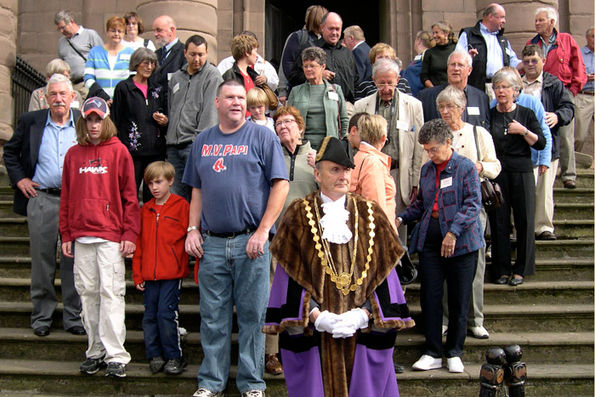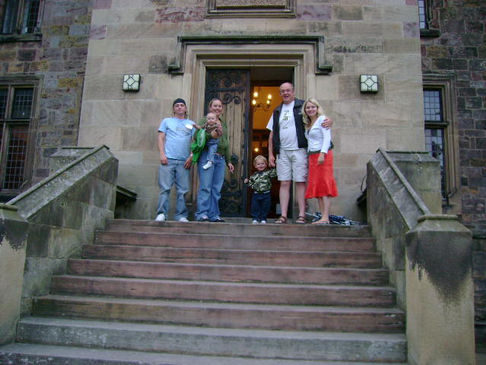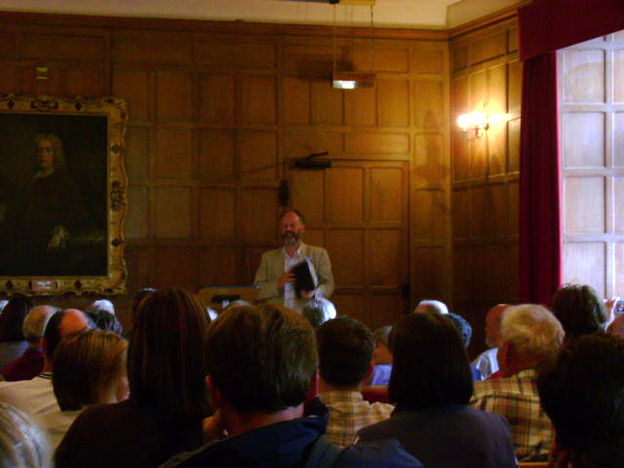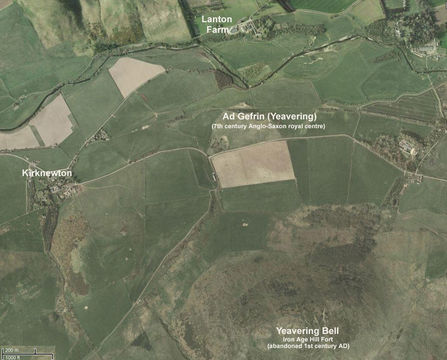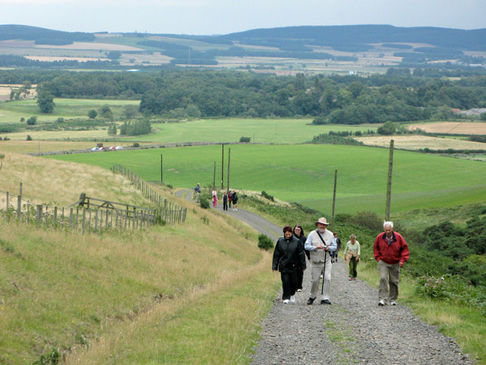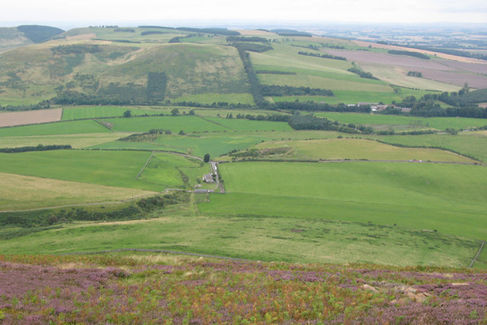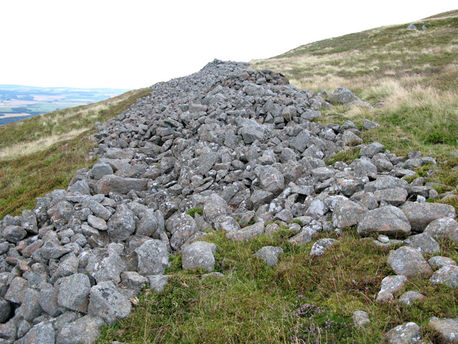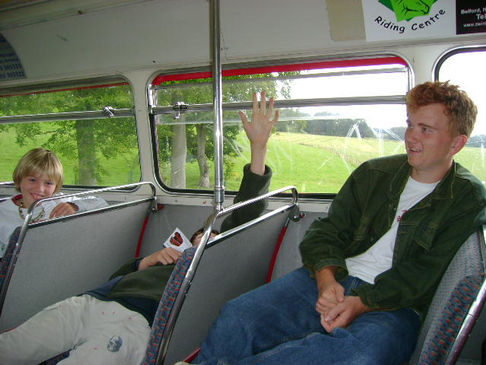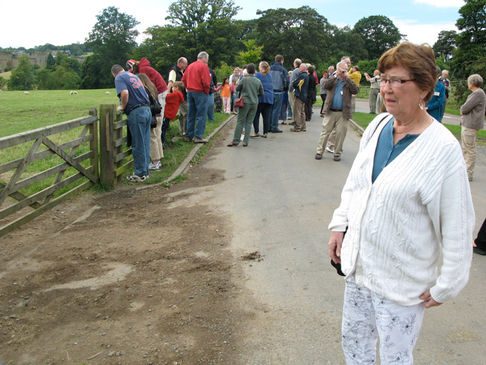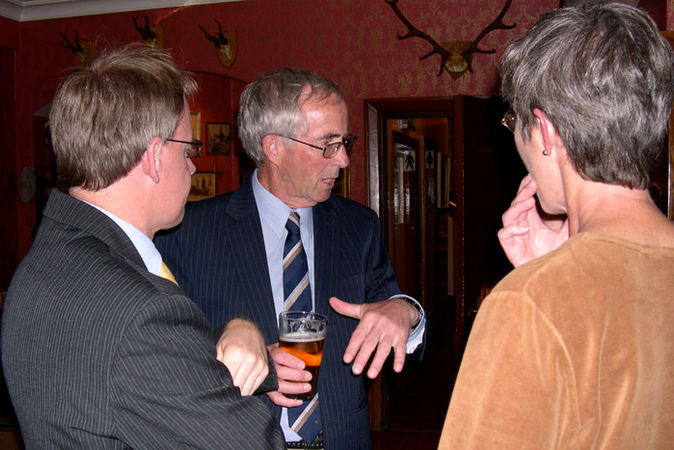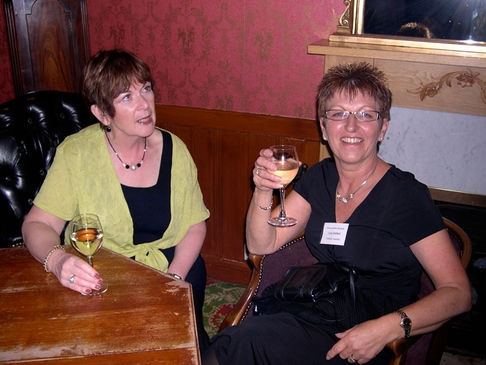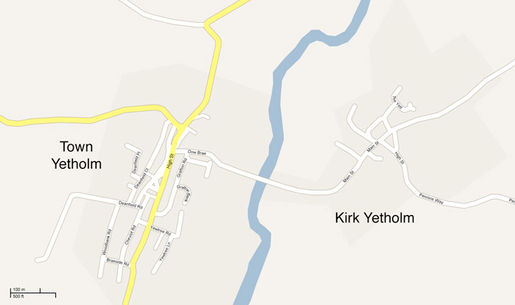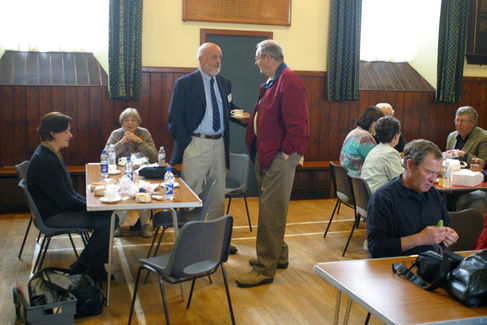Harvey SettLER REUNION (1837-2007)
FORD CASTLE, NORTHUMBERLAND UK
AUGUST 26 - SEPTEMBER 2, 2007
A reunion to commemorate the 170th anniversary of the founding of Harvey Settlement, York County, New Brunswick, Canada was held at Ford Castle, Ford, Northumberland, England from August 26 to September 2, 2007. This reunion was novel in that it was held in the area that the settlers originated from; the Wooler area of Northumberland. The first settlers arrived in 1837 aboard the snow rigged Cornelius of Sunderland and settled as a group to found the community that became known as Harvey Settlement. Through the next 15 years successive waves of friends and relatives arrived from the same area, settling around the first arrivals. There are now many thousands of descendants of these pioneers spread not only throughout Canada and the US, but around the world. About 130 of the descendants of these early settlers gathered to explore the beautiful countryside and small communities between Wooler and the Borders, where many of their ancestors came from.
The planning committee worked three years in organizing the reunion. The reunion would not have been possible though without the assistance and hospitality of many additional people in Northumberland and Berwickshire who provided the reunionists with many hours of their time to help make this reunion a great success.
The reunion garnered media attention in the Borders region on television, radio and in newspaper articles. Follow this link to a summary of print media items.
Below are links to a day by day diary of the reunion complete with photographs. There was also considerable media attention
Monday, 27 August
Morning
Noon
Check-in Ford Castle
Afternoon
3 PM
Reception at Glendale Agricultural Show
Evening
Tuesday, 28 August
Morning
Noon
Afternoon
Introductory Remarks - Al Robison
Welcome - Lord James Joicey
Keynote Lecture - Prof. Bruce Elliott, Carleton University
"New Brunswick Land Company and the Settlement of Harvey and Stanley, NB"
10 AM
Hike up Yeavering Bell near Kirknewton
Hike up College Burn to 'Whitehall"
Evening
Guided tour around Coldstream
Lectures and Reception, Coldstream Historical Society
Prof. Bruce Elliott, Carleton University: "New Brunswick Land Company and the Settlement of Harvey and Stanley, NB"
David Welsh, Northumbria University
"Preemigration professions and way of life of the Harvey settlers"
Wednesday, 29 August
Morning
Noon
9 AM
Double decker bus tour of castles of north eastern Northumberland
Afternoon
3 PM
Civic reception at Berwick Town Hall followed by plaque unveiling at Berwick Quay
Evening
8 PM
Lecture: James Bell
"Battle of Flodden Field"
Thursday, 30 August
Morning
Noon
Hike to "Old Rookland"
12:30
Lunch and refreshment at Clennell Hall Hotel, Alwinton
Afternoon
Visit Alwinton Church and Harbottle
Evening
7 PM
Burns Supper at Coldstream
friday, 31 August
Morning
Noon
Afternoon
Evening
10 AM
Day trips to Cheviots or Dumfriesshire or free time.
Berwick Records Office open for reunion attendees
8 PM
Lecture: Prof. Tim Patterson, Carleton Univ.
"Genetic Genealogy: A Primer"
Saturday, 1 September
Morning
Noon
10 AM
Hike across the Cheviot Hills or walking tour of Wooler with local guides
12 PM
Picnic lunch at Harthope Burn
Afternoon
Walk along the Burn or up the hill to meet Cheviot hikers
Evening
7 PM
Evening conference banquet at Ednam House Hotel, Kelso Remarks by Ian Herbert
Sunday, 2 September
Morning
Noon
Walk around Town Yetholm
Afternoon
3 PM
Lunch at Wauchope Hall, Yetholm
Church service at Kirk Yetholm
1 PM
Evening
Monday, 3 September
Morning
Noon
Afternoon
Evening
Ford castle residents depart after breakfast
Harvey Settler Reunion
(1837-2007)
Day 1
August 26, 2007
Morning
Noon
Check-in Ford Castle
Afternoon
3 PM
Reception at Glendale Agricultural Show
Evening
Through the day on Monday August 27th (Day 1) the reunion attendees began to arrive at Ford Castle either directly from their homes, or in most cases from other parts of the United Kingdom. Driving through the beautiful Northumberland countryside excitement began to build as reunionists got their first view of their home for the next week -- historic Ford Castle.
There was not much time to explore the castle grounds, renew old acquaintances or make new ones though as the first event of the reunion was about to take place. By happy coincidence the Glendale Agricultural Show was taking place that day and a reception had been arranged in our honor. We piled into our respective cars and mini buses and made our way south to Haugh Head, just beyond Wooler where the fair grounds had been established in some fields. Unfortunately the agricultural component of the 2007 version of the fair was severely curtailed as there had been an outbreak of foot and mouth disease in the south of England and local authorities wisely figured that it would be prudent to keep live stock away.
The fair was still quite large and it was quite a walk to the rear area of the grounds where the Reunion marquee (tent) had been set up courtesy of the Northumberland National Parks Service. The marquee was full of people from the area in addition to the Harvey descendants. The surnames of the Harvey settlers had been well publicised before the event in local newspapers. There was a lot to see as Linda Bankier from the Berwick-Upon-Tweed Records Office had set up a large display on the Harvey settlers and there were other interesting displays and resource material available from the Borders Family History Society and the Northumberland and Durham Family History Society stands. Our own material was also on display showing the voyage of the Cornelius, a ships list, family trees and material on Harvey past and present.
Two very harried people in the room were Linda Bankier and Trevor Swan of our organizing committee who were distributing and collecting DNA test kits. Arrangements had been made with the Sorenson Molecular Genealogy Foundation (SMGF, http://www.smgf.org/) of Utah, a non-profit organization dedicated developing DNA testing as the ultimate genealogical tool. It is hoped that the eventual results of these tests will not only provide evidence of familial links between Harvey settlers and their cousins in the Borders but provide information on settlement patterns in the region through the past two millennia.
This was the first opportunity that the Harvey settler descendants had to interact with their Borders cousins and many enjoyable discussions ensued as everyone drank tea and coffee and snacked on various cakes that had been provided. Reunionists also had the opportunity to shop for souvenirs at various kiosks throughout the fair grounds, watch displays of horsemanship, or enjoy the rides. This was also the first opportunity for some reunionists to meet Lord James Joicey, the proprietor of Ford Castle within the 16,000 acre Ford and Etal Estates, as his Icelandic horse marquee was set up next door to the reunion reception.
Around 5 PM the fair began to wind down and it was time to head back to Ford Castle, find our rooms, and enjoy a hearty meal in the dining room. After unpacking many people headed down to the castle bar to enjoy the beverage of their choice and spent some time getting to know each other.
Harvey Settler Reunion
(1837-2007)
Day 2
August 27, 2007
Morning
Noon
Afternoon
Introductory Remarks - Al Robison
Welcome - Lord James Joicey
Keynote Lecture - Prof. Bruce Elliott, Carleton University
"New Brunswick Land Company and the Settlement of Harvey and Stanley, NB"
10 AM
Hike up Yeavering Bell near Kirknewton
Hike up College Burn to 'Whitehall"
Evening
Guided tour around Coldstream
Lectures and Reception, Coldstream Historical Society
Prof. Bruce Elliott, Carleton University: "New Brunswick Land Company and the Settlement of Harvey and Stanley, NB"
David Welsh, Northumbria University
"Preemigration professions and way of life of the Harvey settlers"
The schedule for the first full day of the reunion on Tuesday August 28th (Day 2) was a busy one with words of welcome, lectures, hikes, tours, receptions and more lectures. The day started with a hearty breakfast in the castle's basement dining area, although many people got an even earlier start, exploring the castle grounds and immediate area just after sunrise. After breakfast we gathered in the great hall of the castle to here some introductory remarks from reunion co-organizer Al Robison who then introduced Lord James Joicey, the owner of Ford and Etal Estates.
He was a very interesting speaker telling of how his family of collier owners from Newcastle purchased the estate and providing interesting details on the history of the castle. He also remarked that he often welcomes groups to Ford Castle but it was the first time that he had ever welcomed anyone back again. This reference was to the fact that it was in Ford Castle, in the very room that we were sitting, that potential settlers went to hear a presentation from the New Brunswick Land Company extolling the virtues of emigrating to New Brunswick.
Reunion co-chairman Ian Herbert then spoke outlining the logistics for the coming week, which were quite complex due to the large number of sometimes simultaneous events going on.
Professor Bruce Elliott of the Department of History at Carleton University, Ottawa, Ontario then presented a fascinating Powerpoint lecture on the New Brunswick Land Company and the Settlement of Harvey and Stanley, NB, which outlined the reasons why the company and others like it existed and why they actively recruited settlers to emigrate from the United Kingdom to Canada. Hearing this lecture in the very hall where our ancestors went to hear about the benefits of migrating made the lecture all the more interesting.
After eating one of the "all that you can carry away" box lunches that were provided by the Ford Castle food staff we all piled into our respective vehicles and headed for our first hike of the day, a "moderate" hike up Yeavering Bell, a twin-peaked hill rising 361 m, near Kirknewton and adjacent to the River Glen (Map Ref: NT918270 Landranger Map Number 74. Latitude 55.536652N Longitude 2.131481W). We parked along the driveway of a farm just off the highway and about two and a half hours later after much huffing and puffing some of the reunionists made it to the top and were treated to a spectacular view of the north Northumberland countryside. Even those who did not make it to the top had a great view. Yeavering Bell and the immediate area is of considerable archaeological significance and has personal significance for some Harvey settler families. The top of Yeavering Bell itself is capped by the best-preserved prehistoric hill fort in Northumberland, with the tumbled down stonework still in existence. Reunionists who looked carefully within the confines of the fort could also see remnants of the platforms where timber built round houses stood. This fort was an important center of the Votadini, an important Iron Age tribe in this region that formed a Roman friendly buffer state north of Hadrian's Wall. Relations probably were not always friendly though as the walls appear to have been deliberately and uniformly flattened, perhaps during a Roman military operation in the 1st century AD. Standing on the walls of the hill fort and looking north we were looking at another important archaeological site -- Adgefrin (See: Yeavering entry Wikipedia for more information; Map Ref: NT925305 Landranger Map Number 74. Latitude: 55.568112N Longitude: 2.120487W).
The Northumbrian Angle King Edwin and his Queen Aethelburg maintained a Palace Complex and great hall known as Adgefrin. The site is of considerable cultural importance as it here that Paulinus of York, at the invitation of the royal couple, spent 36 days preaching and baptizing converts to Christianity in the River Glen. This marked the beginning of the general conversion of the invading Germanic tribes and the rechristianization of the area as the supplanted British tribes that formerly dominated the area had already converted to Christianity in Roman times. The name Adgefrin lives on as it first evolved into Gefrin, which eventually became the word Yeavering, as the area is known today.
A barn structure could also be seen on the grounds of the farm that we passed through to climb this hill. This still used building is also of archaeological significance as it was part of a fortified farm dating from the Reiver era, a thousand years after Adgefrin was abandoned.
From our perch on the hill fort we could clearly see across the River Glen on the edge of Adgefrin to the farm of Lanton and beyond to Milfield. This region is of significance to many Harvey settler families such as the Craigs and Moffitt's as they lived and worked in this area prior to emigration.
The high concentration of important archaeological sites spanning thousands of years of history in such a small geographic area made the reunionists realize what deep roots we all have in that area as we undoubtedly carry the blood of all those peoples who lived here in our veins!
-- A humbling experience.
Following the "moderate" hike up Yeavering those who still had the time and the energy went around Kirknewton and into the College Burn valley. This is a beautiful valley surrounded by high rolling hills and with a view of the Cheviot as you proceed up the valley. Those who made it up the valley were rewarded with a close view of 'Whitehall", the original farm where the Herbert family resided and where Thomas Herbert, one of the original pioneering Harvey settlers, was born in 1798. The visit was cut short by a heavy shower and most of the hikers scrambled into vehicles to escape the rain. All were very pleased though to have made it to this picturesque historic site.
The rain also failed to put a damper on those who attended a very interesting lecture in the Coldstream Parish Church about the history of the town and on the famous Coldstream Guards of the British Army, whose battle honors hung all around us. In the tradition of such artefacts they are not disturbed once hung up. As a result many of the older flags were hanging in tatters. The Coldstream Guards are the oldest regiment in the Regular Army in continuous active service, originating in Coldstream on the Scottish border in 1650 when General George Monck founded the regiment. It can trace its lineage all the way back to the New Model Army on the Parliamentary side of the English Civil War, although Lord Monk marched the Coldstream Guards to London following the death of Cromwell to support the restoration of the monarchy. We learned how the Coldstream marriage house at the Coldstream (Smeaton's) Bridge was a popular 19th century center for marriages for Presbyterians who could not legally married in Church of England dominated Northumberland until the practice was banned in 1856. It was also across this bridge that Robert Burns first crossed into England for the first time in 1787. Upon crossing the bridge he dropped to his knees and prayed:
" O SCOTIA ! MY DEAR, MY NATIVE SOIL !
FOR WHOM MY WARMEST WISH TO HEAVEN IS SENT !
LONG MAY THY HARDY SONS OF RUSTIC TOIL
BE BLEST WITH HEALTH, AND PEACE, AND SWEET CONTENT."
The town was also the location where invading armies crossed into Scotland. Edward I of England invaded Scotland in 1296 destroying the town in the process and heavily damaging the Priory founded by Earl Gospatrick in 1165. We also learned that later in 1545 the Earl of Hertford led the army of Henry VIII through the village, again razing it to the ground and this time completely destroying the Priory. By this time the rain had let up and a short walking tour of Coldstream commenced. As we weaved up and down the streets and through the back alleys we began to appreciate the long history of the town. The blocked up windows on many houses drew questions. We learned that these bricked up windows came about in 1696 when William III introduced a tax on the relative prosperity of the taxpayer. It was presumed that since glass was very expensive then, the more windows that one had would logically indicate that the person was wealthier and could pay more tax. The result was that many chose to sit in the dark rather than pay. Amazingly this strange form of taxation was not repealed until 1851!
By this time other reunionists began to arrive from the castle and we congregated at a local Hall to attend a reception put on by the Coldstream Historical Society and to hear a replay of Bruce Elliott's morning lecture (put on for the benefit of the society members) and a second lecture by David Welsh of Newcastle University who presented a very informative and entertaining lecture on the class structure and the working environment that existed in our ancestor's time. Although they lived in a beautiful landscape our ancestors lived hard lives in their roles as itinerant hinds, shepherds and tradesmen. In the end all agreed that although they had an even tougher time initially as they felled trees to clear their new farms in Harvey they eventually were much better off working land they owned themselves. The new settlers also had the luxury of outhouses in New Brunswick! An interesting side discussion that developed during the lecture was how the farmers thought that it was wasteful to provide outhouses along with the hinds cottages as the common thinking was that the people in them would not use them for their intended purpose but to store coal, potatoes and anything else that they could stuff in them. Instead they were expected to relieve themselves where ever they could. This waste was apparently carefully husbanded and piled out front of the hind cottages (so that no one would steal it!) as a valuable fertilizer for their kitchen gardens. It is surprising that anyone lived to adulthood under the poor sanitary conditions that these people lived under.
After the lecture concluded the members of the Coldstream Historical Society distributed mementos to their Harvey reunion guests and we shared a social hour together enjoying a tasty lunch that was laid out.
For those who had attended most of the activities, this had been a long but most enjoyable whirlwind day. Everyone was in very good spirits as we eventually loaded into our vehicles and headed back to Ford Castle for bed.
Harvey Settler Reunion
(1837-2007)
Day 3
August 28, 2007
Morning
Noon
9 AM
Double decker bus tour of castles of north eastern Northumberland
Afternoon
3 PM
Civic reception at Berwick Town Hall followed by plaque unveiling at Berwick Quay
Evening
8 PM
Lecture: James Bell
"Battle of Flodden Field"
Day three of the reunion was another activity filled day. After another filling breakfast in the dining hall at Ford Castle we walked outside the walls to board a pair of double decker buses that had been hired to take us on a driving tour of northern Northumbria with emphasis on the many castles in the area. Because the Borders has had such a violent past the area has one of the highest concentrations of fortifications in all of Great Britain. Due to time constraints we did not get to tarry long or go inside any of the castles but we got nice views of them and from our perches on the top deck of the buses superb views of the Northumbrian countryside.
After lunch we had a bit of down time and then it was off for one of the most important events of the entire reunion - the unveiling of a plaque commemorating the sailing of our Mayflower, the Cornelius of Sunderland in May 1837. Prior to the plaque ceremonies we were first given a guided tour of a portion of the walls surrounding Berwick-Upon-Tweed. During the reign of Queen Elizabeth I in the late 16th century, vast sums — one source reports £128,648, the most expensive undertaking of the Elizabethan period — were spent on its fortifications, in the new Italian style (trace italienne), designed both to withstand artillery and to facilitate its use from within the fortifications. This was a major step forward as by this time all the older castles were obsolete as the high curtain walls, designed to withstand sieges could not withstand cannon fire, which explains why so many are in ruins. The fortifications at Berwick-Upon-Tweed were never needed though as the city was never attacked.
We then strolled as a group to the Berwick-Upon-Tweed Town Hall, where a civic reception had been arranged in our honor. Mayor Lance Robison, the Lord High Sheriff xxxx and other city dignitaries were decked out in their robes of office. The Harvey Settler descendants were highly appreciative of the speech read by Mayor Robison where he commemorated the departure of the Harvey settlers aboard the Cornelius 170 years earlier. Harvey Settler descendant Tim Patterson provided a response to the mayor and read a letter of greeting from Mayor Winston Gamblin of Harvey. A social hour then commenced, which provided an opportunity for many to chat with the mayor and his colleagues and to view the array of historical posters that had been set up by Linda Bankier of the Berwick-Upon-Tweed records office. Following a group photograph taken by a reporter from the Berwick-Upon-Tweed Advertiser on the front steps of city hall a procession commenced, with the mayor and other dignitaries in the lead, down to the Berwick Upon Tweed quay where the plaque commemorating the settlers voyage was to be unveiled. The Cornelius actually departed from just across the Tweed River at Carr Rock in Tweedmouth as the vessel was too large to dock at the quayside. However, it was decided to put the plaque on the Berwick-Upon-Tweed side of the river as Carr Rock is now part of a Coast Guard wharf, which is not easily accessible to the public (see images of Carr Rock wharf below).
The plaque was unveiled by Mayor Robison and Harvey settler descendant, 10 year old Kate Jardine (daughter of Nancy Robison) and reads:
______________________
Emigrant Ships From Berwick
Though Berwick was not a major emigration port a number of emigrant vessels departed from there for Canada early in the 19 th . century. Notable among them were two chartered by the New Brunswick and Nova Scotia Land Company. The "D'Arcy" carried a party of Northumberland and Scottish Borders emigrants who settle in Stanley, New Brunswick in 1836. A second party went out in the "Cornelius" of Sunderland in 1837 and founded Harvey in New Brunswick.
"They laid foundations deep and wide on which to build throughout the years."
Erected to mark the Harvey Settlers Reunion 2007.
______________________
It was a moving moment for many as we stood on the quay much as our ancestors had done 170 years earlier. The difference of course being that they were making a great leap into the unknown, leaving their homeland and friends and relatives, whom most would never see again.
Following the unveiling ceremony some reunionists toured around the streets of Berwick-Upon-Tweed for a while before heading back to Ford Castle for another hearty supper.
At 7 PM were treated to a lecture on the Battle of Flodden Field by Flodden expert James Bell, author of "From Boroughmuir to Branxton Moor: The Story of Flodden". A lecture on this topic was entirely appropriate as it was at Ford Castle that James IV of Scotland cavorted all week with Lady Heron (instead of strategizing) prior to being killed along with the majority of Scottish nobility at the Battle of Flodden Field on 9 Sept. 1513 -- the battle site is just visible from the castle walls. The level of detail given by James Bell, provided a new understanding of this important event for those who visited the battlefield. In all likelihood nearly all of the reunionists had ancestors who were involved in the battle or were killed there including reunionists Elizabeth, Malcolm and Calder Patterson who are descendants of Lieutenant General Gillespie 'Archibald' Campbell, 2nd Earl of Argyle, who was killed at the battle.
Following the talk many reunionists retired to the lounge for a pint and a chance to socialize and discuss what had been a very eventful day.
Harvey Settler Reunion
(1837-2007)
Day 4
August 29, 2007
Morning
Noon
Hike to "Old Rookland"
12:30
Lunch and refreshment at Clennell Hall Hotel, Alwinton
Afternoon
Visit Alwinton Church and Harbottle
Evening
7 PM
Burns Supper at Coldstream
We gathered at a gateway in Biddlestone near Alwinton in the morning. A Canadian and an Australian flag flew in a stiff breeze to show reunionists that they had reached the correct destination but some had trouble finding the place along the narrow winding roads. Walkers set off up the hill to the morning's destination - "Old Rookland'. Those that couldn't make the climb up the hill were conveyed up to the old farmhouse by a Land Rover. This conveyance and the driver were kindly supplied for us by the Northumberland National Parks Department. Thanks go to Judie Freeman, Community Enterprise Assistant with the NPD, for arranging this.
Up at Old Rookland about 70 people gathered and Ian Herbert was able to introduce some visitors to the attendees:
Tom Snaith, from the neighbouring farm at Biddlestone.
Elizabeth Elder, a Wanless descendant and fourth cousin to many in the group. Elizabeth is the sister of Sarah Nelson and has been in correspondence with Ian Herbert for a number of years, having met in Northumberland in 2003.
Margaret Sinclair and her brother Richard Hayes. Margaret has also corresponded with Ian for some time but this was their first face to face meeting. Margaret and Richard are descendants of Archibald Herbert, miller at great Tosson. Archibald was the brother of Cornelius immigrant Thomas Herbert (1798).
Old Rookland was farmed by the Dagg family in the 1930's up to the start of World War II and then fell into disrepair. Life on the farm was described in a small book written by Margaret Dagg that was made available to reunion attendees. Robert Herbert (1768), the father of Thomas Herbert (and Archibald) was the tennant farmer at Rookland from before 1827 to some time after 1831 ie at the time of the Cornelius voyage. It was here that Robert's wife Isabella Wanless died in 1831 and her body was conveyed back over to Scotland to be buried at Hownam. Tom Snaith was able to describe the rooms of the building to the group. It's in a lonely place, high in the Cheviot Hills. Farming here must have been terribly hard and it must have been especially difficult for Robert's wife Isabella.
After many photos and capturing the feel and remoteness of the place we departed for Clennel House Hotel back down in the valley near Alwinton. This could be reached on foot over the hills or by the use of the Land Rover and cars again. Clennel House is in a beautiful settting and was a great place for lunch and refreshments. For those contemplating a walking holiday in the region or furthering their family history research (or both) it would make an ideal base.
After lunch we travelled past the small village of Alwinton to Alwinton Church. This is a special place for Herbert descendants as it is here that three of Thomas Herbert's brothers are buried - Archibald, George and Robert - and a nephew Robert (son of Robert). Also buried here are two Wanless relatives. Where they all are on the family tree was explained to us by our guests Margaret and Richard who came prepared with charts for the occasion and we thank them for this. It's possible that Robert Herbert (1768) is also buried here though no legible gravestone can be found. We need to examine the old church records.
As an extra bonus a lady from the Church guild invited us to help ourselves to the tea making facilities in the church. This was much appreciated and we took the time to soak in the history of this old place of worship while enjoying a cup of tea and a place to sit. A 14th century crypt under the high stairs in the church was originally used by the Clennell family but was allotted to the Selby family in the 19th century. The Selbys were the landowners for whom Robert Herbert was a tennant farmer, their ancient seat being at Biddlestone. It should be noted that while the graves of our ancestors are in this churchyard, being a Church of England it was not their place of worship. They went on further on Sundays to the Presbyterian Chapel at Harbottle. Laws of the time and the absence of public cemeteries meant they had to be buried in the Church of England graveyard (or conveyed to Scotland in the case of Isabella).
The group then made their way back to Wooler and Ford, some taking the time to have a look at the small village of Harbottle with its castle ruin. Susan Herbert, a daughter of Archibald, was the postmistress in this village for over 50 years in the 1800s.
In the evening a special Burns supper was held for us by the Coldstream Robbie Burns Club. As quoted on the souvenir scotch whiskey bottles handed to the reunionists: "To mark the occasion of the visit of the descendants of Borderers who sailed for New Brunswick in the Year of our Lord 1837".
The evening started off with the piping in and cutting of the haggis before we settled down to an enjoyable dinner. The Coldstream club went all out for us with numerous amusing speeches, solos and recitations, such as the Tam O'Shanter -- all performed by men with wonderful Scottish brogue. In short the evenings entertainment was extraordinaire and will be long remembered by all in attendance. Lots of toasts and raised glasses.
Harvey Settler Reunion
(1837-2007)
Day 6
September 01, 2007
Morning
Noon
10 AM
Hike across the Cheviot Hills or walking tour of Wooler with local guides
12 PM
Picnic lunch at Harthope Burn
Afternoon
Walk along the Burn or up the hill to meet Cheviot hikers
Evening
7 PM
Evening conference banquet at Ednam House Hotel, Kelso Remarks by Ian Herbert
Day 6 of the reunion comprised a variety of events. For the adventurous Ian Herbert led a challenging hike across the Cheviot Hills with some folks traveling to the end of the hike to meet up with them.
Others took part in an interesting walking tour of Wooler, led by xxxx of the xxxx who discussed the various points of interest in the community as well as the various places of worship that would have been in use at the time when the Harvey settlers emigrated in 1837.
That evening the long- anticipated evening conference banquet took place at the Ednam House Hotel in Kelso. Moving speeches were made by a number of reunion attendees summing up their feelings in having had the opportunity to visit so many places where their various ancestors had lived and the fine hospitality that had been shown to them.
_______________________________
Harvey Settlers Reunion
Evening Address at Ednam House, Kelso
by Ian Herbert
Saturday 1st September
Welcome to Ednam House, Kelso. I hope you have had a good day – we certainly have.
The very first thing I would like to say is that I have been in touch with Ewen Herbert in Melbourne and he sends his best wishes to all of you. He and Betty would have dearly liked to be here but Ewen’s health has prevented the journey; however they are represented here tonight by there three nephews Peter Searle and Don and Robin Lawson, together with Dianne, Felicity and Jennifer. Ewen and Betty have actually stayed here at Ednam House five times. It’s one of their favourite places and we can see why.
In the introduction in the reunion book you will have read how Dora Hunter met up with Ewen back in 1976. Almost 30 years later here we are gathered together again. It’s very pleasing to have Kirsten Opdebeck, a great great niece of Dora’s, here with us tonight.
Ewen continued to stay in touch with Dora and when she passed on he corresponded with Marlene MacMillan. Marlene has been responsible for organising many of the early Robison reunions and Pam and I had the pleasure of attending the last one in Lethbridge in 2003. We first visited this border country and Northumberland and then flew over to meet up with Marlene and Don at their home in Nova Scotia. We then drove with Marlene to Harvey Station where we received a very warm and memorable welcome. We’ll be back there again later this month. We then flew to Alberta to meet more of the Robison clan (more third cousins as two Herbert sisters married two Robison brothers).
Presentation of a Quaich to Marlene
in thanks for the part she has played in bringing us all together.
Traditionally the ‘Quaich’, a small silver or pewter vessel which originated in the Scottish Highlands, was used both for a cup of welcome and also when offering a farewell drink. The distinctive design has remained unchanged over the centuries.
Now I must offer an apology. I have to admit that easy walks are really moderate, moderate walks are hard and hard walks are extreme. Congratulations to everyone who got out to explore the hills, to experience their beauty and to reflect on the lives our forefathers lead, or perhaps endured. We come from a fine tradition of walking. Thomas Craigs used to walk the six miles each way from Milfield to church in Wooler each Sunday. When he arrived in Harvey at age 70+ he is said to have walked to Red Rock in a day, a distance of over 50 miles, and only towards the end of his life did he stop the night at Fredericton. It is recorded too that Margaret Little nee Herbert and her sister, probably Isabella Little, walked and ran to Fredericton and back in a day, exchanging eggs and butter for shop goods. They were spurred on to get home before dark by the thought of bears in the woods. Here in the borders there is a network of public footpaths on the ordinance survey maps and these are the very same paths that our ancestors walked.
Before 2002 most of us knew very little about our Northumberland and Borders origins. What a difference this discovery has made to our lives. We have travelled to some beautiful places and our Harvey, UK and Australian cousins have all been brought together.
I’d like to introduce one of my Australian cousins to you. You may have met Peter Searle during the week but let me tell you just a little about him. He and I have some uncanny similarities. We both do orienteering as a sport, we both did tertiary studies in physics, we were both married on January 5th and we both have a bit of a tremor in our right hands ( an ‘essential tremor’ the doctor’s call it but I don’t really consider it essential).
Now we’ve put this down to our common ancestor Robert Herbert but Tim Patterson in his talk on Genetic Genealogy tells us that the common genetics between third cousins once removed is something like .001% or some low number. Don’t believe him! You mustn’t let facts like that get in the way of a good story.
Talking of likenesses and DNA, did you like the gypsy story? Are you shocked? Are you proud of it? (Much clapping from the audience).
Tomorrow we visit Kirk Yetholm, the home of the gypsies. Back in the 1851 census there were just two families named Herbert in Roxburghshire, both in Yetholm. (There was also a single 13 year old lad, Robert Herbert, who was Ewen’s great uncle and who was living and working as an errand boy with his uncle Robert Shiel at Sourhope). The last Herbert living in Yetholm was Tibby Herbert who died in early 2000.
Before the reunion I had an extensive article published in the Southern Reporter, a local Borders newspaper. I was trying to trace a branch of the Yetholm Herberts who moved to Galashiels early in the 1900’s. I received three responses from the article. The first was from David Roseburgh who operates a genealogy service called Scottish Genealogy www.scottishgenealogyrresearch.com who offered to supply me with the family tree. We were in the UK when I got to read his email with the results of his research. A tree was supplied which descended all the way to five living brothers. The second response was an email from one of those brothers ‘Billy Herbert’. Billy lives in Duns but couldn’t meet me as he was going to London to see a show with his brother Robert who was over visiting from Tasmania! His sister-in-law Karen is the family genealogist and I arranged to visit her and her husband Doug at their home in Galashiels, just a few blocks away from the Robert Herbert Engineering works (see the photo on page 61 of the reunion book). The first thing Doug said to me, unprompted, was that their family story is that we are descended from the gypsies of Yetholm. I shook his hand when I heard that! Furthermore Doug has offered to take a Y DNA test to prove that we are indeed cousins.
The third response was from a Cath Henderson nee Herbert in Selkirk who believes she is descended from the Herberts of Yetholm from her childhood trips there to meet up with relatives. On Friday Pam and I spent a couple of hours in the Berwick Record Office and we’re now well on the way to putting the whole Yetholm family together and hopefully proving all the linkages.
Over at the Record Office we met up with Bob Grieve, Bob & Gertrude Wilson and Barney & Adelia Robison who were all exploring their family connections. We wish everybody much success with their research and please stay in touch through the internet with all your findings.
I hope you will all take home some wonderful memories of the week. Personally I’ll never forget Thursday when we walked up to Old Rookland, had lunch at Clennel House and then visited the Alwinton Church. Margaret Sinclair and her brother Richard met up with us. I had only had email contact with Maragret before this meeting. She is a descendant of Archibald Herbert, the brother of Thomas Herbert who sailed on the Cornelius. She and Richard had charts with them and explained to people just which ancestors were buried at Alwinton (including Archibald). It’s probable that ggg grandfather Robert Herbert is also buried there with three of his sons.
And what of the Burns Supper! On a night like that it makes you proud to be Scottish – whatever side of the border you come from. Those people are so talented.
Hopefully you have all got to experience Life past and present here in the Borders and in Northumberland – by bus, through history and DNA talks (top rate), by car or minibus exploring the towns and villages, visiting Alnwick (for a Harry Potter experience) or Hadrians Wall (for a Roman experience) and at Ford Castle, a tremendous venue.
We have met some wonderful hosts, met some really great people and had terrific support.
Tomorrow we will have our own thanksgiving service at Yetholm. Some may miss this because of school terms so we wish them Bon Voyage and hope to see you again. After the service we all return home and what then? Hopefully we will all have new projects and new adventures. I wish you good health and happiness and may we met again. Please stay in touch.
Thank you.
Ian Herbert
Harvey Settler Reunion
(1837-2007)
Day 7
September 02, 2007
Morning
Noon
Walk around Town Yetholm
Afternoon
3 PM
Lunch at Wauchope Hall, Yetholm
Church service at Kirk Yetholm
1 PM
Evening
On Sunday September 2 we drove to the twin communities of Town Yetholm and Kirk Yetholm to have lunch and to attend a church service at the Kirk in Kirk Yetholm. Town Yetholm and Kirk Yetholm are separated by the Bowmont Water, which flows out of the Cheviots. Yetholm is on the border between Scotland and England and it is therefore fitting that it's name is derived from the old Scots word 'yett' meaning a gate, and 'holm' or 'ham'; the Anglo-Saxon word for a settlement. Yetholm is probably best known today as the northern terminus for the Pennine Way walk. It is also on St. Cuthbert's Way, which is on the route between Melrose, the location of St. Cuthbert's early monastic life, to Lindisfarne (Holy Island), the area of St. Cuthbert's later ministry and death. Yetholm was once also the center of Gypsy culture in the Borders. A memorial has been erected in their honor on the green in Kirk Yetholm.
After strolling around Town Yetholm for a while in the late morning many reunion attendees congregated in Wauchope Hall (until 1914 the United Presbyterian Church) for a box lunch and to view displays on the history of Yetholm that had been set up for us to view. After a leisurely lunch and discussions with local people about their communities history it was time to head across the bridge to the service in Kirk Yetholm.
The established Church of Scotland church in Kirk Yetholm is an impressive building of black basalt construction, which replaced an old thatched roof church on the same site in 1836, just prior to the settlers departing in 1837. The original church dating from the 12th century was a low building with a roof thatched with reeds and a floor below ground level. Many Harvey settler descendants have many ancestors who worshipped on this site. Specific close familial connections to the church that stood on this site include:
Thomas Herbert, grandfather of Thomas Herbert who migrated aboard the Cornelius to found Harvey Settlement in 1837,
married Christian Crozer here in 1758.
George Cleghorn Sr., father of George Cleghorn who emigrated to Harvey Settlement in 1853, married Jane Dickson here
on 27 Feb 1803.
We unfortunately could not see the present church in all its glory as it was undergoing renovation, to 'ensure that the building can last a few more generations' and thus covered with scaffolding when we visited. However, even through the scaffolding we could see that the Kirk was an impressive edifice.
Although our ancestors left soon after the new church was consecrated there is a familial connection to the present church. On page 212 of the 2006 book 'Bygone Yetholm: Portrait of a Border Village (ISBN 0--9554149-0-3 and ISBN 978-0-9554149-0-9' published by the Yetholm History Society, which many reunion attendees purchased there is a reference to the construction of the church:
'Built of local whinstone quarried from 'Staerough', the hill behind
the village, the stones all hand cut and built by Mr (Andrew) Herbert the
local mason and builder at the time. He also built the bridge over the Bowmont between the villages.'
The bridge has been said to be a testament of Andrew Herbert's skill as it survived the devastating floods of 1948, which washed away many other bridges in the area. Andrew Herbert (1803-), a cousin of the Thomas Herbert who emigrated with the rest of the Cornelius party in 1837.
More detailed information on the churches that have stood on this site may be found at:
http://www.yetholm.bordernet.co.uk/history/church.html
The service began with a very nice piano introit by Yoshi Nowlin. After a warm welcome by the local Anglican Priest, the Reverand Ian Clark, who was standing in for the ailing Church of Scotland minister, the Rev. Robin McHaffie, the service was taken over by settler descendant the Rev. Barney Robison and assisted by settler descendant Rev. Bradley Little. It was a moving experience for many to worship on the site where many of our ancestors worshipped so long ago. Several psalms were sung that would have been familiar to the first settlers, although as Presbyterians they would not have been accustomed to musical accompaniment. Several Harvey settler descendents participated in the 'pick-up' choir ably directed by Colleen Whelan. Choir members included Brad Little, Megan Nowlin, Tim Patterson, Nancy Robison, Wendy Robison and Tom Smith.
Title of Barney Robison's Sermon: "He Sought a Country"
Passage: Hebrews 11:8-16
Key Verse: Hebrews 11:14
Summary: Barney's message compared the Harvey Settlers with the patriarch, Abraham, both of whom left their place of birth
and traveled to an unknown land. The Harvey Settlers trusted in the Land Company, Abraham in God. The Bible said that Abraham
desired a heavenly home whose builder and maker is God. As pilgrims like Abraham we all desire a heavenly home when
our earthly pilgrimage is over. Abraham died in faith and was not disappointed. Similarly those who die in Christ will not be
disappointed.
Ewen Herbert through Ian Herbert has reported that the text that Barney chose was by coincidence the same as that delivered at Otterburn Chapel on the death of Barney's 4th great grandfather Robert Herbert in 1846:
'The Christian Pilgrim' A Sermon preached in Otterburn Chapel, after the death of an Elder, by the Rev. Anthony L. Christie,
Otterburn.
This sermon was also based on Hebrews chapter 11 verses 13 & 16 although to get the full meaning of the text one should
read the whole of chapter 11.
Following the service some people tarried a while and chatted outside the church prior to heading back to Ford Castle.


